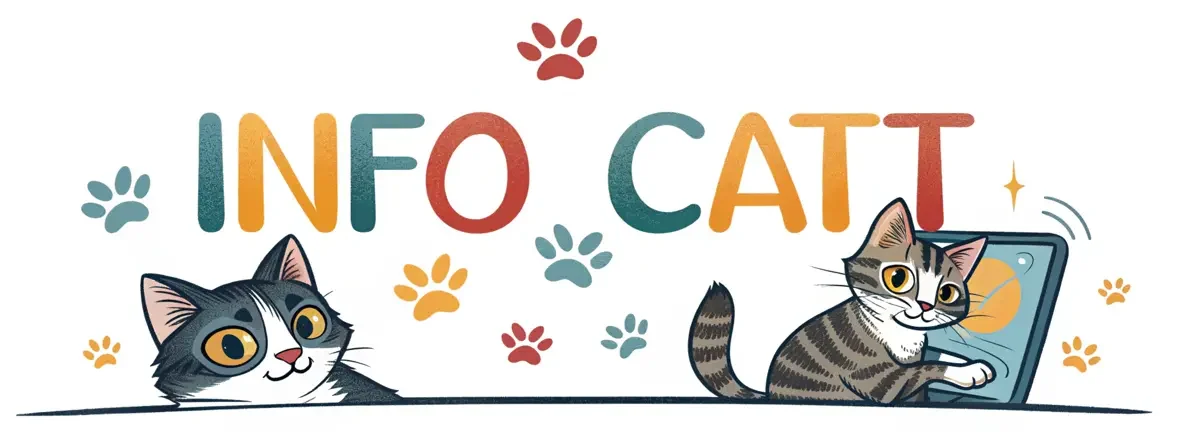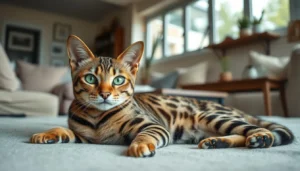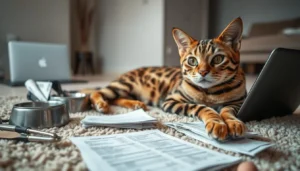Have you ever been captivated by a Bengal cat’s stunning spotted coat? These cats are more than just pets. They are living art, blending wild beauty with home charm. Welcoming a Bengali cat is like inviting a miniature leopard into your family.
This Bree Of cats mix exotic looks with loving companionship. Their wild looks hide a smart and lively personality. Before you fall in love, it’s key to know what makes them special.
These cats aren’t for everyone. They need owners who can keep up with their energy and provide mental fun. With their striking looks and playful nature, This cats offer a unique pet experience.
Understanding the Bengal Cat Breed History and Origins
This Cat breed has a fascinating origin story. It starts with a remarkable scientific experiment. These stunning felines emerged from a unique crossing between domestic cats and wild Asian Leopard Cats. This created one of the most distinctive cat breeds in the world.
The journey of the Cat Bengal began in the 1960s. Geneticist Jean Mill first tried to breed a domestic cat with a wild Asian Leopard Cat. Her goal was to create a domesticated cat with the wild appearance of its exotic ancestor. She wanted it to have a friendly temperament.
The Wild Asian Leopard Cat Connection
Asian Leopard Cats are small wild felines native to parts of Asia. These beautiful creatures became the foundation for developing the Bengal cat breed. Unlike other wild cats, they were relatively smaller. This made them more suitable for experimental breeding programs.
- Native to regions in Asia
- Smaller wild cat species
- Distinctive spotted coat pattern
Development of the Modern Bengal
Creating a stable Bengali cat breed took multiple generations of careful breeding. Breeders worked to maintain the wild aesthetic. They also ensured the cats were gentle and adaptable to domestic life. The typical Bengal cat size ranges from medium to large. They have muscular bodies that reflect their wild heritage.
Breed Recognition and Standards
The International Cat Association (TICA) officially recognized the Bengali cat breed in 1983. Today, these cats are prized for their unique appearance. This includes their leopard-like spots and athletic build. Breed standards now carefully define the Bengali cat’s characteristics. This ensures the preservation of their remarkable lineage.
Bengali Cat Personality Traits and Temperament
This cats are truly special as pets. They mix wild charm with domestic love. These cats are not like regular house cats. They bring lots of intelligence and fun to your home.
Exploring bengal cat behavior shows their amazing traits:
- They have very high energy and need lots of play.
- They are super smart and can solve problems easily.
- They love to explore and learn about their world.
- They can learn tricks and commands quickly.
Bengals are very good at talking to people. They use different sounds to tell you what they need or feel. They also love water, which is rare for cats. This is because of their wild ancestors.
Your Bengal needs lots of brain work. They need toys, puzzles, and playtime to stay happy. Their hunting skills make them love to play and challenge themselves.
A Bengalien cat is not just a pet, but an interactive family member who will keep you constantly entertained and engaged.
Even though they look wild, Bengals are very loving. They are loyal and social. They love to be with their family and join in on all activities.
If you’re looking for a cat that enjoys independence but still forms a strong bond with its owner, The Russian Blue Cat is a great choice. However, if you want a more social and attention-seeking breed, the Bengali Cat might be a better fit, as they thrive on human interaction and even enjoy learning tricks.
Essential Care Requirements for Your Bengal Cat
Getting a Bengali Breed means you need to be ready for their special needs. These cats are full of energy and smart. They need extra care to do well at home.
Caring for a Bengali Breed is more than just being a pet owner. They have a wild side, so they need more than a regular home. Their needs are different from those of common house cats.
Living Space and Environmental Needs
Your Bengalien Breed needs a place that’s fun and challenging. Make their space like their natural habitat:
- Install tall cat trees for vertical exploration
- Provide multiple perching areas
- Create secure indoor play zones
- Consider a secure outdoor catio for supervised adventures
Grooming and Hygiene Routines
Teaching your Bengali Breed to groom is important. Their short fur is easy to care for. But, regular grooming keeps them healthy:
- Brush weekly to remove loose fur
- Trim nails every 2-3 weeks
- Clean ears monthly
- Maintain dental hygiene with regular brushing
Exercise and Enrichment Activities
This Cats need a lot of exercise and mental play. They are very active and need lots of fun activities:
- Interactive puzzle toys
- Laser pointer play sessions
- Fetch games
- Training with positive reinforcement
Pro tip: Rotate toys frequently to keep your Bengal engaged and prevent boredom.
Health Considerations and Life Expectancy
Knowing about This Breed health is key for pet owners. This cats live 12 to 16 years with the right care. Your dedication to their health greatly affects their life quality.
Important health points for Bengali cat owners include:
- Genetic predispositions to specific medical conditions
- Importance of regular veterinary screenings
- Potential inherited health challenges
The common health issues in Bengalien cats are:
- Hypertrophic cardiomyopathy – a heart muscle condition
- Progressive retinal atrophy affecting vision
- Potential joint problems like hip dysplasia
Good healthcare can extend your Bengali cat’s life. Regular vet visits, genetic tests, balanced diet, and exercise are vital. Your vet can offer advice on preventing and managing breed-specific health risks.
Preventative care is the key to a long, healthy life for your Bengal companion.
By tackling health issues early, you can keep your Bengal cat healthy and lively for years.
Cost of Ownership and Initial Investment
Getting a Bengal breed means planning your budget carefully. The price can change a lot, so it’s key to know the costs before you decide.
Thinking about a Bengal kitten? You’ll need to budget for both the first costs and ongoing expenses. These cats are more than pets; they’re a special friend you’re investing in.
Purchase Price Range
Bengal cat prices usually fall between $1,500 and $5,000. This depends on a few important things:
- Pedigree quality
- Coat pattern and color
- Breeder reputation
- Where you live
Monthly Care Expenses
Plan to spend each month on your Bengal cat’s needs:
- Premium cat food: $50-$100
- Litter and supplies: $30-$50
- Toys and fun activities: $20-$40
- Regular vet visits: $20-$50
Medical and Insurance Costs
Even though Bengal Breed might seem hypoallergenic, they need good medical care. Pet insurance can cost $30 to $50 a month. It helps cover health issues that might run in the breed.
Pro tip: Always save for unexpected vet bills to keep your Bengal cat healthy and happy.
Knowing all the costs helps you decide if a Bengal cat is right for your family.
Conclusion
Bringing a Cat Bengal into your home is an exciting journey. It requires careful thought and preparation. These cats are not just pets but dynamic companions with unique traits.
They need dedicated attention and understanding. Your lifestyle, living space, and commitment to their high-energy needs are key. They will thrive in your environment if you meet these requirements.
The Bengal cat personality is unique. They are intelligent, playful, and have a wild-like energy. They need mental stimulation, interactive play, and structured environments.
While their stunning appearance might attract you, remember the commitment needed. Ensuring their physical and emotional well-being is crucial.
Successful Breed Bengal ownership requires consistent engagement and proper healthcare. They are active participants in household dynamics. Owners need to understand their complex nature and meet their care needs.
Before deciding, assess your ability to provide a stimulating lifestyle. Bengal cats are not for everyone. They demand a lot from their owners.
For the right person, a Bengalien Breed can be an extraordinary companion. Their vibrant personality, athletic build, and engaging temperament make them exceptional pets. Your readiness to embrace their unique characteristics will determine your success with this breed.
FAQ
Are Bengal cats good pets for families with children?
Bengali cat can be great for families, but they need watching with kids. They love to play and are smart, which means they enjoy games. But, their energy and hunting skills mean teaching kids how to play nicely with them is important.
They usually get along well with older kids who know how to be gentle. This helps everyone have fun together.
How much does a Bengal cat typically cost?
Bengali Breed Cat can cost between $1,500 and $5,000. The price depends on the cat’s bloodline, coat, and the breeder’s reputation. Cats with special markings or show quality might cost more.
Remember, you’ll also need to budget for food, vet visits, and other supplies.
Do Bengal cats require special dietary considerations?
Yes, Bengali Breed need a diet rich in protein. Choose high-quality food with real meat first. Many owners give them both wet and dry food, focusing on protein.
Talk to your vet to find the best diet for your Bengal.
How much exercise do Bengal cats need?
Bengali Cat need lots of exercise and mental games. Aim for 30-60 minutes of playtime each day. They like puzzle toys, climbing, and games that challenge them.
Without enough activity, they might get bored and act out.
Are Bengal cats hypoallergenic?
Bengali Cats are not truly hypoallergenic. They have a short coat that might produce fewer allergens, but they can still cause allergies. If you’re allergic, try spending time with a Bengal before getting one.
What health issues are common in Bengal cats?
Bengali Cats can face health issues like heart disease, eye problems, and hip issues. They might also have digestive problems and be more likely to get viruses. Regular vet visits and a healthy lifestyle can help prevent these problems.
How long do Bengal cats typically live?
Bengali cat can live 12-16 years with the right care. Diet, exercise, genetics, vet care, and lifestyle all play a role. Indoor cats tend to live longer, avoiding dangers outside.
Do Bengal cats get along with other pets?
Bengali Breed Cat live with other pets, but they need to be socialized early. They usually get along with dogs and cats, but introduce them slowly. Their hunting instinct means they might not be good with small pets like birds or hamsters. Always watch when introducing new pets.
,500 and ,000. The price depends on the cat’s bloodline, coat, and the breeder’s reputation. Cats with special markings or show quality might cost more.
Remember, you’ll also need to budget for food, vet visits, and other supplies.
Do Bengal cats require special dietary considerations?
Yes, Bengal need a diet rich in protein. Choose high-quality food with real meat first. Many owners give them both wet and dry food, focusing on protein.
Talk to your vet to find the best diet for your Bengal.
How much exercise do Bengal cats need?
Bengal need lots of exercise and mental games. Aim for 30-60 minutes of playtime each day. They like puzzle toys, climbing, and games that challenge them.
Without enough activity, they might get bored and act out.
Are Bengal cats hypoallergenic?
This Cats are not truly hypoallergenic. They have a short coat that might produce fewer allergens, but they can still cause allergies. If you’re allergic, try spending time with a Bengal before getting one.
What health issues are common in Bengal cats?
This Cats can face health issues like heart disease, eye problems, and hip issues. They might also have digestive problems and be more likely to get viruses. Regular vet visits and a healthy lifestyle can help prevent these problems.
How long do Bengal cats typically live?
This Cats can live 12-16 years with the right care. Diet, exercise, genetics, vet care, and lifestyle all play a role. Indoor cats tend to live longer, avoiding dangers outside.
Do Bengal cats get along with other pets?
This Cats can live with other pets, but they need to be socialized early. They usually get along with dogs and cats, but introduce them slowly. Their hunting instinct means they might not be good with small pets like birds or hamsters. Always watch when introducing new pets.



